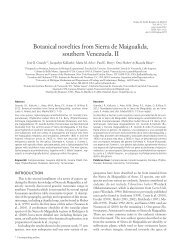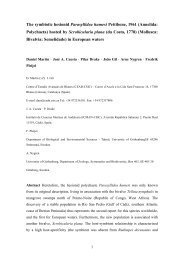FUNCTIONAL AND BIOACTIVE PROPERTIES OF COLLAGEN AND ...
FUNCTIONAL AND BIOACTIVE PROPERTIES OF COLLAGEN AND ...
FUNCTIONAL AND BIOACTIVE PROPERTIES OF COLLAGEN AND ...
Create successful ePaper yourself
Turn your PDF publications into a flip-book with our unique Google optimized e-Paper software.
2011b). Dávalos, Miguel, Bartolomé, and López-Fandiño (2004) studying individual amino acid<br />
activity reported that Trp, Tyr and Met showed the highest antioxidant activity, followed by Cys, His<br />
and Phe. The rest of the amino acids did not show any antioxidant activity. However, many peptides<br />
have been described as having antioxidant capacity without containing any of the above mentioned<br />
proton-donating amino acid residues in their sequences. Thus, Kim et al. (2001a) isolated two<br />
peptides composed of 13 and 16 amino acid residues, respectively from Alaska pollack skin, both of<br />
which contained a Gly residue at the C-terminus and the repeating motif Gly-Pro-Hyp. Li, Chen,<br />
Wang, Ji and Wu (2007) identified the peptide which exhibited the highest antioxidant activity from<br />
porcine skin collagen hydrolysates as Gln-Gly-Ala-Arg. The peptide Asn–Gly–Pro–Leu–Gln–Ala–<br />
Gly–Gln–Pro–Gly–Glu–Arg was purified from squid skin gelatin with a valuable free radical<br />
quenching capacity (Mendis et al., 2005a). Furthermore, the antioxidant activity of collagen and<br />
gelatin peptides has been linked to the high content of hydrophobic amino acids, which could increase<br />
their solubility in lipids and therefore enhance their antioxidative activity (Kim et al., 2001a).<br />
Rajapakse, Mendis, Byun and Kim (2005) found that fish skin gelatin peptides showed higher<br />
antioxidant activity than peptides from meat protein, probably because of the higher percentage of<br />
Gly and Pro.<br />
Not only is the presence of proper amino acids essential, but their correct positioning in the peptide<br />
sequence plays an important role too in antioxidant activity. Peptide conformation has also been<br />
claimed to influence antioxidant capacity, showing both synergistic and antagonistic effects, as far as<br />
the antioxidant activity of free amino acids is concerned (Hernández-Ledesma et al., 2005). As<br />
mentioned above, protease specificity used for hydrolysis may determine the size and the sequence of<br />
the peptides, and as a result their antioxidant activity. In different studies, it has been found that<br />
alcalase gelatin-derived hydrolysate antioxidant activity was higher than that of other enzyme<br />
hydrolysates such as those obtained by collagenase, pepsin, trypsin, chymotrypsin, papain or neutrase<br />
(Alemán, Giménez, Montero & Gómez-Guillén, 2011a; Qian et al., 2008). Moreover, antioxidant<br />
activity is strongly related to peptide molecular weight as demonstrated by Gómez-Guillén et al.<br />
(2010) who found antioxidant activity in all the peptide fractions from squid skin hydrolysate, but that<br />
it was higher in the fractions with lower molecular weight. Similarly, the peptide fraction from cobia<br />
skin hydrolysate, with most of the molecular mass values below 700Da showed the highest radical<br />
scavenging activity, being approximately 20% higher than that of the non-fractionated hydrolysate<br />
(Yang et al., 2008).<br />
5.3.- Antihypertensive/ACE inhibitory activity<br />
Antihypertensive peptides are peptide molecules which may lower blood pressure when ingested<br />
through inhibition of vasoactive enzymes such as the angiotensin converting enzyme (ACE). ACE<br />
plays an important role in the regulation of blood pressure by means of the rennin-angiotensin system,<br />
22

















